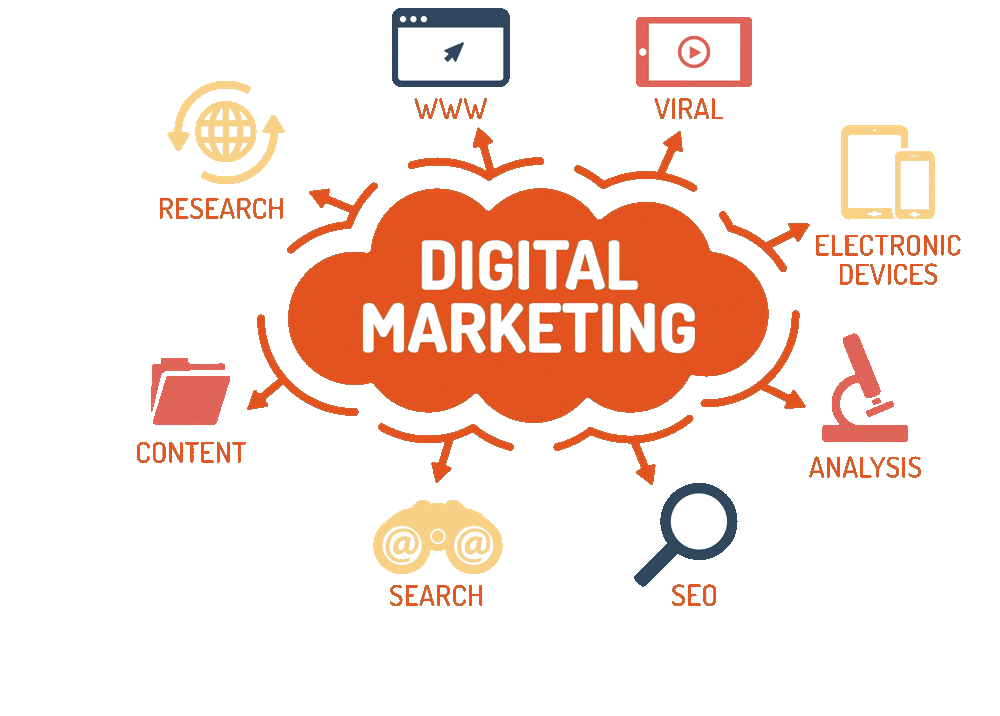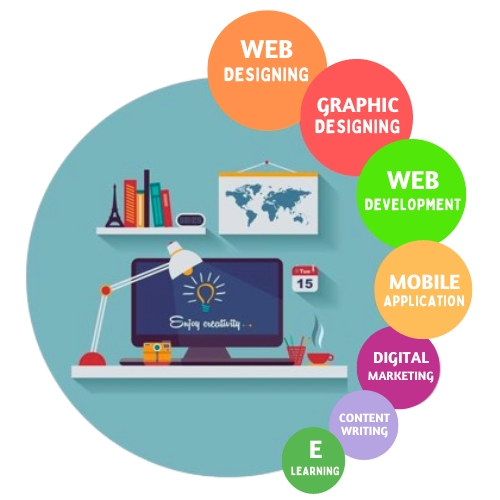Digital marketing in bangalore
Defining Digital Marketing and its Core Aspects
The digital age has revolutionized how businesses connect with their customers. In today’s hyper-connected world, digital marketing reigns supreme. This comprehensive guide delves into the core concepts of digital marketing, its growing importance, and the ever-evolving landscape businesses navigate to reach their target audience online.
Digital marketing encompasses all marketing efforts that utilize electronic devices and the internet. It’s a multifaceted approach that goes beyond simply advertising online. Here are some key aspects of digital marketing:


The Shift to Digital: A Changing Landscape
The digital marketing landscape has undergone a significant transformation over the years. Here’s a glimpse into this ongoing evolution:
- Early Days (1990s): The rise of the internet brought the first wave of digital marketing with email marketing and basic website creation.
- Search Engine Marketing Boom (2000s): Search engines gained prominence, leading to the development of search engine optimization (SEO) and pay-per-click (PPC) advertising.
- Rise of Social Media (2000s-Present): The explosion of social media platforms like Facebook, Twitter, and Instagram revolutionized how brands connect with their audience.
Core Concepts of Digital Marketing
Building on the essential foundation of understanding your audience, this section will delve deeper into the intricate world of digital marketing. We’ll explore the vast digital ecosystem, examining how it fundamentally differs from traditional marketing channels and the unique opportunities it presents.
In the digital landscape, the immediacy of communication, the breadth of available channels, and the depth of customer interaction data stand in stark contrast to traditional marketing methods. Here, marketing is not just about reaching out to the audience but engaging with them in a dynamic, two-way interaction that can be finely tuned in real time.


Understanding the Digital Ecosystem
The digital marketing ecosystem encompasses all the interconnected digital channels, tools, and platforms used to reach and engage your target audience online. It’s a complex yet dynamic network where various elements work together to achieve your marketing objectives. Here’s a breakdown of some key components:
- Owned Media: These are the digital assets you control, such as your website, social media profiles, blogs, and email lists. Owned media allows you to directly communicate your brand message and build relationships with your audience.
- Earned Media: This refers to the publicity and brand mentions you gain organically through online conversations, reviews, influencer marketing, and social media shares. Positive earned media can significantly increase your brand awareness and credibility.
Social Media Marketing Essentials
Social media platforms have transformed into a pivotal force within the digital marketing landscape, offering unparalleled opportunities for brands to engage directly with their target audiences. This section delves into the fundamentals of social media marketing, providing comprehensive guidance on how to effectively harness the power of these platforms. We aim to equip you with the strategies needed to connect authentically with your audience, foster vibrant communities, and successfully achieve your marketing objectives.
We will begin by examining the unique characteristics and strengths of key social media platforms, including Facebook, Instagram, Twitter, LinkedIn, and newer entrants like TikTok. Understanding the nuances of each platform is crucial for crafting tailored content that resonates with specific audiences. We’ll explore how demographic differences across platforms can influence content strategy and communication styles.
Harnessing the Potential of Social Platforms
Social media platforms offer a unique opportunity to connect with your target audience in a real-time, interactive environment. Here’s how to leverage their potential: Brand Awareness and Visibility: Social media platforms allow you to build brand awareness and increase your brand’s visibility among your target audience. Regularly posting high-quality content can establish your brand as a thought leader in your industry
Community Building and Engagement: Social media fosters community building by enabling you to interact directly with your audience, respond to comments and messages, and participate in conversations relevant to your brand.
Targeted Marketing and Advertising: Social media platforms offer sophisticated targeting options that allow you to reach specific demographics, interests, and online behavior patterns. This enables highly targeted marketing campaigns that resonate with your ideal customers.
Building and Nurturing Communities
Thriving social media marketing hinges on building and nurturing online communities around your brand. Here’s how to cultivate a loyal following: Identify Your Target Audience: Clearly define your ideal customer on each social media platform. Understand their interests, preferred content formats, and online behavior patterns.
Post Consistently and Valuably: Develop a consistent posting schedule and provide valuable content that resonates with your audience. This could include informative blog posts, engaging videos, industry insights, or entertaining behind-the-scenes glimpses into your brand.
Embrace Two-Way Communication: Encourage interaction with your audience by asking questions, responding to comments, and participating in conversations.
Leveraging Social Listening for Insights
With a wildcard SSL certificate, you can secure a base domain and as many subdomains as you want. If you want to secure more than one sub-domain, it’s cheaper to buy a Wildcard SSL certificate than to buy separate SSL certificates for each one.
Brand Sentiment Analysis: Track the sentiment (positive, negative, neutral) surrounding your brand mentions online. This allows you to identify areas where you’re excelling and address any negative feedback promptly.
Identify Industry Trends: Monitor social media conversations to stay updated on industry trends, competitor activities, and emerging customer needs. This allows you to adapt your content strategy and marketing efforts accordingly.
Search Engine Optimization (SEO)
In the modern digital marketplace, where the majority of consumer purchase journeys initiate from a simple search engine query, securing a high ranking on search engine results pages (SERPs) is not just beneficial but essential for online success. This section delves deeply into the realm of Search Engine Optimization (SEO), offering an extensive exploration of strategies designed to enhance your website’s organic visibility and draw in more qualified traffic via search engines.
We will start by dissecting the core principles of SEO, including the importance of keywords, the role of quality content, and the impact of backlinks.
Fundamental Principles of SEO
SEO encompasses a set of practices aimed at improving a website’s ranking in search engine results pages (SERPs) for relevant keywords. Here are some core SEO principles to understand.
Keywords: Keywords are the terms users enter into search engines to find information. Identifying relevant keywords and strategically incorporating them into your website content is crucial for SEO success.
On-Page Optimization: On-page optimization refers to optimizing the elements within your website that you have control over. This includes page titles, meta descriptions, header tags, content quality, internal linking structure, and image optimization.
Off-Page Optimization: Off-page optimization focuses on factors outside of your website that influence search engine ranking. This primarily involves building backlinks (links from other websites to yours) and establishing your website’s authority and credibility.
Strategies for On-Page and Off-Page Optimization
On-Page Optimization
- Keyword Research: Conduct thorough keyword research to identify relevant keywords with high search volume and low competition.
- Content Optimization: Create high-quality, informative content that targets your chosen keywords and addresses your audience’s needs.
- Title Tags and Meta Descriptions: Craft compelling title tags and meta descriptions that accurately reflect your content and entice users to click on your website in search results.
- Header Tags: Utilize clear and descriptive header tags (H1, H2, etc.) to structure your content and improve readability.
Off-Page Optimization
- Link Building: Acquire high-quality backlinks from reputable websites relevant to your industry. This demonstrates your website’s authority and trustworthiness to search engines.
- Guest Blogging: Contribute guest blog posts on other websites within your niche, including a link back to your own website.
- Social Media Engagement: Promote your website content on social media platforms to generate buzz and encourage organic link building.
- Online Reputation Management: Actively manage your online reputation by addressing negative reviews and building positive brand sentiment.
On-page and off-page optimizations are crucial pillars of SEO strategy. On-page optimization ensures your site is well-structured and content-rich, directly influencing rankings. Off-page optimization, through backlinks and social signals, boosts your site’s authority and reach.
Together, they create a robust foundation for improving your website’s search engine visibility.
Monitoring and Adapting to Algorithm Changes
Staying Ahead in SEO: Adapting to Algorithm Changes
Track Your Website’s Ranking: Utilize SEO tools to track your website’s ranking for relevant keywords over time.
Monitor Algorithm Updates: Stay updated on the latest search engine algorithm updates and adjust your SEO strategy accordingly.
Focus on User Experience: Prioritize creating a positive user experience on your website. This includes fast loading speeds, mobile-friendliness, and a clear, user-friendly interface.
High-Quality Content Remains King: While algorithms evolve, consistently creating high-quality, valuable content that resonates with your target audience remains a core SEO principle.

Pay-Per-Click (PPC) Advertising

Pay Per Click Concept. Tiny Characters at Huge Computer Desktop with Cursor Clicking on Ad Button. Ppc Business, Cpc Advertising Technology, Sponsored Listing. Cartoon People Vector Illustration
Introduction to PPC: Beyond the Basics
While SEO focuses on organic visibility, PPC (Pay-Per-Click) advertising offers another powerful tool for reaching your target audience in search engine results pages (SERPs) and other online platforms.
PPC advertising involves creating targeted online advertisements displayed on search engines, social media platforms, and other websites. You only pay when a user clicks on your ad, driving qualified traffic to your website or landing page.
PPC advertising involves creating targeted online advertisements displayed on search engines, social media platforms, and other websites. You only pay when a user clicks on your ad, driving qualified traffic to your website or landing page.
Crafting Effective Ad Campaigns
Keyword Targeting: Select relevant keywords that users are likely to search for when seeking products or services like yours. Compelling Ad Copy: Write clear, concise, and persuasive ad copy that grabs attention and entices users to click. Landing Page Optimization: Ensure your landing page aligns with your ad copy and offers a seamless user experience to convert clicks into leads or sales.


Optimizing PPC Campaigns for ROI
Tracking and Analytics: Monitor your PPC campaigns closely using analytics tools to track performance metrics like click-through rates (CTR), conversion rates, and return on investment (ROI). Bid Optimization: Continuously optimize your bids based on campaign performance. Allocate more budget to high-performing keywords and adjust bids for less effective ones. A/B Testing: Test different ad variations with A/B testing to identify the most effective combinations of keywords, ad copy, and landing pages. By implementing these strategies, you can create high-performing PPC campaigns that deliver targeted traffic, generate leads, and maximize your return on investment.
Email Marketing Mastery
Email marketing continues to be a formidable instrument in the digital marketer’s toolkit, offering a direct line to customers that nurtures lasting relationships and drives meaningful conversions. This expanded guide delves into mastering the art and science of email marketing, equipping you with advanced strategies and insights to effectively engage your audience.
We’ll explore the nuances of crafting compelling email content that resonates with recipients, from the importance of an attention-grabbing subject line to the creation of personalized messages that speak directly to the individual needs and interests of your subscribers. Furthermore, we’ll discuss the integration of visually appealing design elements and responsive templates that ensure your messages look great on any device.


Building Subscriber Lists and Segmentation
In digital marketing, effectively building a robust subscriber list and implementing strategic segmentation are key to maximizing campaign success and enhancing customer engagement. Start by creating compelling opt-ins, such as ebooks, discounts, or exclusive content, to encourage sign-ups. Utilize multiple channels including your website, social media, and even offline interactions to grow your list. Ensure that sign-up forms are prominently placed and easy to complete. Incorporate calls-to-action in blogs, videos, and guest posts to further promote subscriptions, and collect emails during engaging events like webinars and conferences.
Designing Engaging Email Campaigns
Compelling Subject Lines: Craft captivating subject lines that pique interest and encourage users to open your emails.Mobile-Friendly Design: Ensure your emails are optimized for mobile devices, where most users check their email. Clear Calls to Action (CTAs): Tell your audience what you want them to do next, whether it’s visiting your website, making a purchase, or downloading an offer.


Automating Email Workflows for Efficiency
- Welcome Series: Create automated welcome email sequences that introduce new subscribers to your brand and offerings.
- Abandoned Cart Reminders: Utilize email automation to send gentle reminders to users who abandon their shopping carts.
- Nurture Leads with Valuable Content: Automate email workflows that deliver targeted content based on user behavior and interests, nurturing leads and driving conversions.
By building a targeted subscriber list, crafting engaging email campaigns, and automating workflows, you can leverage email marketing effectively to connect with your audience, promote your brand, and achieve your marketing goals.
Exploring Evolving Technologies and Trends
- The Rise of AI and Machine Learning: Artificial intelligence (AI) and machine learning will play a more prominent role in personalizing marketing campaigns, optimizing content delivery, and gaining deeper customer insights.
- The Metaverse and Virtual Reality: The metaverse and virtual reality experiences will offer new avenues for immersive marketing experiences and brand engagement.
- Focus on Voice Search Optimization: With the rise of voice search technology, optimizing content for voice search queries will become increasingly crucial.

FAQs
The key principles of digital marketing include understanding the target audience, creating valuable and relevant content, leveraging multiple digital channels, optimizing for search engines, and continuously analyzing and refining strategies based on data insights.
Building a successful digital marketing strategy involves defining clear goals, identifying target audiences, conducting market research, selecting appropriate digital channels, creating engaging content, implementing effective tactics, and regularly measuring and analyzing performance metrics.
Content marketing is essential in digital marketing as it involves creating and distributing valuable, relevant, and consistent content to attract and engage a target audience. By providing useful information and addressing customer needs, businesses can build trust, establish authority, and drive conversions.
Best practices for social media marketing include defining clear objectives, choosing the right platforms for the target audience, creating engaging content, maintaining a consistent brand voice, actively engaging with followers, and analyzing performance metrics to optimize strategies.
- Digital Marketing Services
- Brand Consultancy
- Website Design Services
- Web Hosting & Domain Registration in India
- Dynamic Website Development
- Website Redesign Service
- Website Maintenance Service
- AMC & IT Support
- Ecommerce Website Design Services
- SSL Certificate (HTTPS)
- Content Writing
- Complete Email Service
- G Suite Services
- Microsoft Office 365 Email Services
- Zoho Email Services
- ERP Bangalore
- Custom Web Application Development
- Mobile App Development and Services
- Android Application Development
- iOS Application Development
- Windows Application Development










